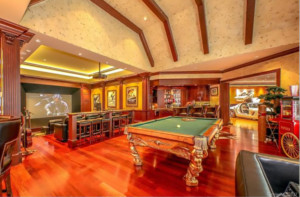 The strategic selection of wood flooring warrants careful consideration. Choices such as oak, maple, and cherry offer not only beauty but also impressive longevity. In the realm of engineered hardwood, a multitude of veneer options exist. These options cater to varied decor themes, spanning from traditional to contemporary. It is imperative to navigate moisture management effectively to safeguard against potential damage. In this guide, we delve into the aesthetic and financial merits of hardwood floors. Furthermore, we present a structured approach to leveraging this flooring choice, aiming to enhance home value with both efficacy and elegance.
The strategic selection of wood flooring warrants careful consideration. Choices such as oak, maple, and cherry offer not only beauty but also impressive longevity. In the realm of engineered hardwood, a multitude of veneer options exist. These options cater to varied decor themes, spanning from traditional to contemporary. It is imperative to navigate moisture management effectively to safeguard against potential damage. In this guide, we delve into the aesthetic and financial merits of hardwood floors. Furthermore, we present a structured approach to leveraging this flooring choice, aiming to enhance home value with both efficacy and elegance.
Financial Impact of Hardwood Floors
The financial implications of wood floor installations require detailed analysis. Notably, Realtor.com has revealed an interesting fact. Installing wood floors can increase home value by up to 2.5%. This uplift presents dual advantages. Firstly, it enhances the aesthetic appeal of the property. Secondly, it adds a numerical increase to the property’s value.
Moreover, hardwood floor refinishing is an essential factor to consider. This procedure revitalizes the material. It also prolongs its longevity. It aids in maintaining and potentially raising the value from the initial investment. This method ensures the continuation of both aesthetic and financial benefits. Therefore, all immediate and ongoing costs and benefits need examination. This includes considering refinishing. Comprehensive scrutiny ensures a clear understanding of its financial impact.
Insights from Real Estate Agents
Estate agents often provide important information on market trends. In particular, they comment on the impact of hardwood on property values. A survey from the National Wood Flooring Association sheds light on this matter. It shows a significant agreement among agents. Four out of five believe that hardwood positively affects a home’s value. They indicate a potential property value boost from 1% to 10%. This variation relies on factors such as the type and quality of the hardwood.
Potential Financial Upswing
In evaluating the financial uplifting, a hypothetical case offers a lucid view:
— Let’s consider a property valued at $300,000 as a foundational figure for calculation.
— With the introduction of hardwood floors, the augmentation in the property’s worth, as per the above-stated ranges (1% – 10%), could hence vary between $3,000 and $30,000.
— This not only facilitates a recoupment of the initial investment in flooring but also positions the homeowner to potentially realize a substantial return on investment.
Balancing Aesthetic and Functional Merits
Hardwood floors are not only visually charming, but also utilitarian in nature, offering numerous advantages. Firstly, basic care suffices for maintenance, involving routine activities such as sweeping and occasional mopping. Secondly, wood floors usually allow for refinishing cycles. These can take place every seven to ten years, significantly prolonging their lifespan. Furthermore, hardwood provides a strong defence against common wear and tear. High-quality versions can potentially last for several decades. Considering hardwood floors of a standard thickness, which is three-quarters of an inch, they ensure continuous functionality and aesthetic allure. This makes them a viable long-term investment.
Strategic Deployment and Material Selection
The act of implementing hardwood floors necessitates strategic choices that influence both the preliminary financial outlay and eventual Return on Investment (ROI). Material selection, in itself, provides a broad array of options, each with its unique considerations:
Economical Options: For instance, pine, which can be priced as low as $1 to $4 per square foot.
Premium Varieties: Such as Brazilian walnut, which may range from $8 to $14 per square foot.
Additionally, vital decisions pertaining to design, pattern, and type are paramount in ensuring the added value is optimized. This requires a meticulous amalgamation of aesthetic cohesion and resilience.
Financial Considerations
Attentive examination of the financial commitment and expected Return on Investment (ROI) for hardwood floors is pivotal, necessitating the consideration of several numerical insights.
Installation costs generally range between $4 and $8 per square foot. However, premium woods or complex installations might increase these costs. The expected ROI is between 70% and 80%, according to Professional Builder. This expectation aligns with the noted increase in property value upon sale. Additional costs may arise from periodic refinishing. This may happen three to five times during the floor’s lifespan and cost between $3 and $5 per square foot.
When assessing lifespan against cost, it’s imperative to weigh the initial expenditures against the potential century-long lifespan of well-maintained wood floors. Despite local market variations and specific hardwood types, these floors emerge as a substantial method to enhance a property’s intrinsic and market value, demanding a meticulous analytical approach to maximize their potential.
Considering the Environmental and Health Aspects
The environmental and health impacts of hardwood merit thorough consideration. The market offers numerous eco-friendly options, such as bamboo, which regenerates in a mere five years, and cork, known for its sustainability. These materials attract environmentally conscious buyers and may meet specific green building standards.
Hardwood does not harbour allergens as much as carpets and is relatively easy to clean of dust and pet dander. Thus, it can be a significant asset for buyers focusing on healthy indoor environments. Additionally, the thermal properties of hardwood might impact heating and cooling costs, subtly influencing a home’s energy efficiency, especially in certain geographical locations.
Products certified by groups like the Forest Stewardship Council can enhance a property’s appeal. Such certifications can attract environmentally-conscious buyers. This material is vital for a healthy interior. It doesn’t trap allergens like carpets and ensures cleaner air. For individuals with respiratory issues, maintaining air quality is particularly essential. Moreover, it doesn’t release volatile organic compounds (VOCs), safeguarding indoor air quality.
Final Thoughts
Choosing this type of surface demands thorough thought. Both financial and aesthetic aspects are crucial. The material can elevate a property’s value by 3-5%. It enhances visual allure as well. Additionally, refinishing is crucial, guaranteeing the ongoing allure and durability of the investment.


